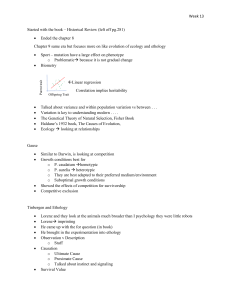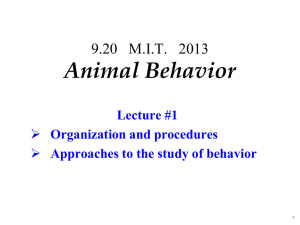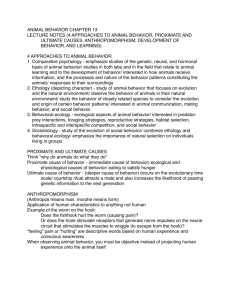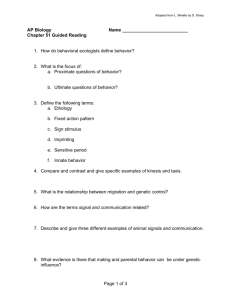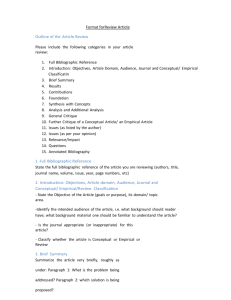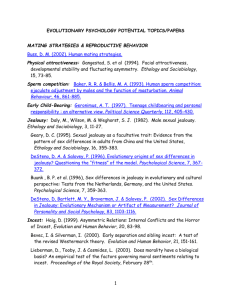ThemeGallery PowerTemplate
advertisement
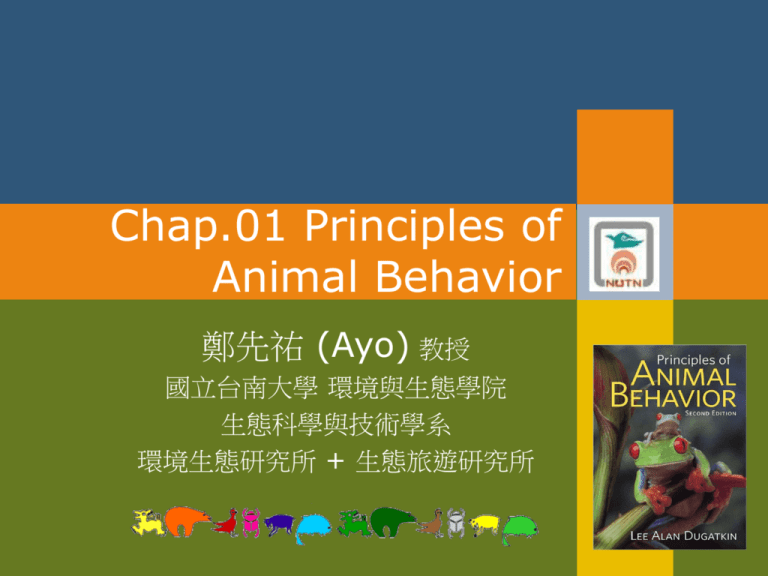
Chap.01 Principles of Animal Behavior 鄭先祐 (Ayo) 教授 國立台南大學 環境與生態學院 生態科學與技術學系 環境生態研究所 + 生態旅遊研究所 Text book Principles of animal behavior 2nd. Ed. Author: Lee Alan Dugatkin 2009, W. W. Norton & Company, Inc. 2 Preface The heart, an examination of the empirical, theoretical, and conceptual foundation upon which the field of animal behavior rests. My aim is to explain underlying concepts in a way that is scientifically rigorous but, at the same time, accessible to students. The goal is to produce a book that instructors can use in their courses as well as in their research programs. 3 Major features 1. A balanced treatment of proximate and ultimate factors 2. Learning and cultural transmission presented alongside natural selection and phylogeny. 3. A thorough integration of proximate factors, including neurobiology, endocrinology, development, and molecular genetics. 4. An extensive discussion of phylogeny 5. Interviews of prominent researchers at the end of every chapter. 6. The Norton animal behavior DVD 4 Contents in brief (I) 1. 2. 3. 4. 5. 6. 7. 8. 9. 5 Principles of animal behavior The evolution of behavior Proximate factors Learning Cultural transmission Sexual selection Mating systems Kinship Cooperation Contents in brief (II) 10. Foraging 11. Antipredator behavior 12. Communication 13. Habitat selection, territoriality, and migration 14. Aggression 15. Play 16. Aging and disease 17. Animal personalities 6 Chap.01 principles of animal behavior Introduction Types of questions and levels of analysis Three foundations 1. Natural selection 2. Individual learning 3. Cultural transmission Conceptual, theoretical, and empirical approaches 1. Conceptual approaches 2. Theoretical approaches 3. Empirical approaches Interview with Dr. E. O. Wilson An overview of what is to follow 7 Ethology Although ethology overlaps with ecology, they are different disciplines, with ecologists focusing on the interaction of organisms with their environment, and ethologists investigating all aspects of animal behavior. The study of animal behavior appears to have been so fundamental to human existence that the earliest cave painting tended to depict animals. 8 Almost everyone is familiar with the roach, often a pest in households around the world. 9 This pendant (垂飾) from the Chrysolakkos funeral complex in Crete. 10 The drawing my depict a “lateral intimidation” during an aggressive encounter between antelopes. 11 12 Types of questions and levels of analysis Four types of questions 1. Immediate stimuli (cue factors) (致使因素) 2. Development (發展、發育) 3. Survival function (Natural selection) 4. Evolutionary history (phylogeny) Two levels 1. Proximate analysis (近因分析) 2. Ultimate analysis (極因分析) 13 Three foundations 14 1 Natural selection (天擇) 2 Individual learning (學習) 3 Cultural transmission (文化傳承) Foundation 1 – Natural selection (A) a field cricket with normal wings (B) a field cricket with flat wings. (C) Sandfly larvae in a parasitized cricket. 15 Xenophobia: a fear of strangers 16 17 Foundation 2– Individual learning 18 Foundation 2– Individual learning 19 20 21 22 23 Not only did grasshoppers in the learning condition approach the balanced diet dish more often, but this translated into quicker growth. Growth rate in grasshoppers is positively correlated with egg size and number. 24 Foundation 3– Cultural transmission (A)When a rat scavenges in the trash, it may encounter new food items that are dangerous or spoiled and that can lead to illness or even death. (B) smelling another rat provides olfactory cues about what it has eaten. This transfer of information from one rat to another about safe foods is a form of cultural transmission. 25 Information center hypothesis Observer rats had a tutor (demonstrator) who was trained to eat rat chow containing either (CO) or cinnamon (CIN) flavoring. Once the observer rats had time to interact with a demonstrator rat, the observer rats were much more likely to add their tutor’s food preferences to their own. 26 27 Conceptual, theoretical, and empirical approaches (觀念、理論與實驗途徑) 28 In many species, like the vervets shown here, mothers go to extreme lengths to provide for and protect their young offspring. W. D. Hamilton’s kin selection ideas provided a conceptual framework for understanding the special relations that close genetic relatives share. 29 30 Theoretical approaches (理論途徑) 31 Empirical approaches (實驗途徑) 32 Interview with E. O. Wilson (i) Sociobiology is the study of the biological basis of all forms of social behavior and social organization in all kinds of organisms, including humans, and organized on a base of ethology and population biology. Not in 1975 book (sociobiology), but in 1971 paper (Sociobiology: The New synthesis. I added the vertebrates to the social insects and suggested that sociobiology could serve as a true scientific foundation for the social sciences. 33 Sociobiology: the new synthesis 34 Interview with E. O. Wilson (ii) Animal behavior is a fundamental and extraordinarily interesting subject in its own right. it is also basic to other disciplines of biology, all the way from neuroscience and behavioral genetics to ecology and conservation biology. Is crucial to conservation biology and its applications. 35 Contents in brief (I) 1. 2. 3. 4. 5. 6. 7. 8. 9. 36 Principles of animal behavior The evolution of behavior Proximate factors Learning Cultural transmission Sexual selection Mating systems Kinship Cooperation Contents in brief (II) 10. Foraging 11. Antipredator behavior 12. Communication 13. Habitat selection, territoriality, and migration 14. Aggression 15. Play 16. Aging and disease 17. Animal personalities 37 Discussion questions (i) 1. Why do we need a science of ethology? What insights does this discipline provide both the scientist and the layperson? 2. Imagine that you are out in a forest, and you observe that squirrels there appear to cache their food only in the vicinity of certain species of plants. Construct a hypothesis for how this behavior may have been the result of (a) natural selection, (b) individual learning, and (c) social learning. 38 Discussion questions (ii) 3. What are the primary differences between individual learning and social learning? 4. What is the key difference between observational and experimental studies in ethology? What are some possible advantages to each type of each type of study? 5. Why do you suppose that mathematical theories play such a large part in ethology? Couldn’t hypotheses be derived in their absence? Why does mathematics force an investigator to be very explicit about his or her ethological hypotheses? 39 問題與討論 Ayo NUTN website: http://myweb.nutn.edu.tw/~hycheng/

